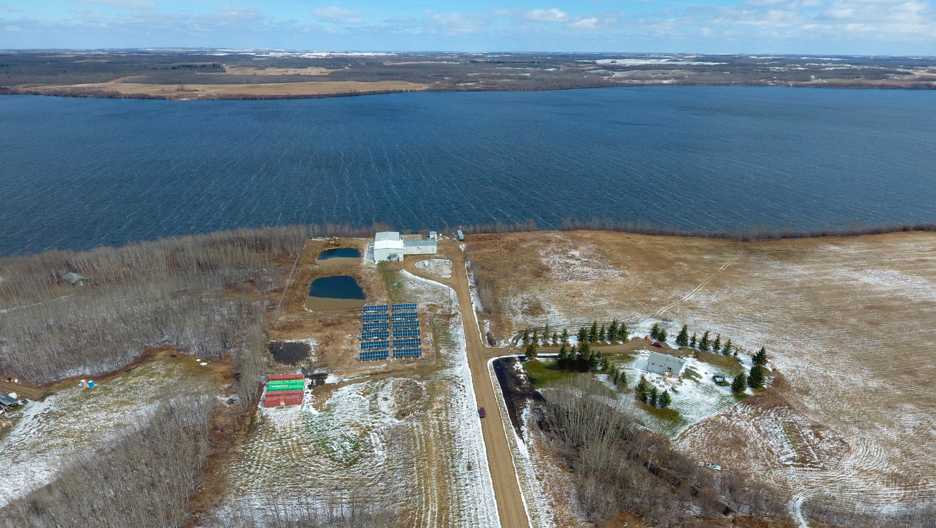After completing a Rural Waterline Feasibility Study in 2017 and an On-Reserve Source Water Protection Plan in 2018, the Saddle Lake Cree Nation retained Urban Systems Ltd. to complete a Climate Change and Source Water Vulnerability Assessment of the Nation’s water source, Saddle Lake, to understand the viability of the Nation’s water supply under impacts from climate change, and increased water demand due to population and economic growth. In October 2019, the Climate Change and Source Water Vulnerability Assessment was released.
Saddle Lake Cree Nation began this project by engaging our youth, elders and general membership in a dialogue about water, climate change and perceived adaptability to address water security. In past projects we have engaged our community in a similar way but have found it difficult to extend the results of the engagement and the project itself beyond those in attendance at the sessions. Because we are a community that traditionally shares knowledge through oral teachings, the idea of documenting the project in a video was proposed. The scope of this project included community engagement sessions, projecting future climate change events related to Saddle Lake, a water quantity assessment, a water quality assessment, and a documentary with the intention that this video will be used to educate our members about our impact assessment of climate change on our ability to fulfill our growing community’s basic need for water, as well as our efforts to preserve the lands, resources and culture of our people.
The community engagement sessions brought forward knowledge that validated historical hydrological modeling which informed future climate change projections. The Assessment revealed that increasing temperatures will magnify the negative impacts associated with contaminants entering the lake. To protect Saddle Lake from such impacts, the Saddle Lake Cree Nation recognized the need to implement the strategic plan previously identified in their 2017 Protection Plan. The Assessment found that Saddle Lake water levels are expected to increase, ensuring adequate water quantity for the community. Another outcome of the Assessment revealed that the water treatment plant is equipped to handle changes in water quality however additional funding is required to invest in the water treatment system and to train the next generation of operators (a vulnerability noted by this study).
Overall, the Assessment revealed that Saddle Lake will remain a viable long-term water source for the community. However, due to the importance of Saddle Lake as a water source for the community, a number of adaptation strategies were outlined for consideration and implementation to increase the resiliency of Saddle Lake and to ensure the continued supply of clean drinking water to the community. These adaptation strategies included:
- Implementation of a buffer zone around the lake
- Raising awareness of the Source Water Protection Plan in the community
- Eliminate wastewater outfalls around the lake
- Development of a water quality monitoring program
- Development of a formal Water Treatment Plan performance monitoring program
- Development of user-friendly summaries of day to day operations
- Development of a standard operating procedures for the Water Treatment Plant
- Confirmation that pathogen reduction recommendations are being met
- Assessment of the environmental impacts of the Water Treatment Plant residual disposal
- Hiring of an additional Water Treatment Plant operator
- Conduct a full analysis of operations and maintenance costs for the Water Treatment Plant
- Conduct a cost benefit analysis of continuing to operate and maintain the Water Treatment Plant
- Completion of floodplain mapping for the lake
- Investigation of the influence of neighboring communities and beaver damns on the inflow to Saddle Lake
- Collect a depth profile of Saddle Lake to improve the understanding of the lake’s storage volume
- Continue to pursue the rural waterline expansion project to improve water delivery to our homes
- Engagement with the youth on source water protection, water treatment, and climate change
- Conduction of a feasibility study for developing an emergency back-up water supply
- Decommissioning of old groundwater wells
By commissioning the Climate Change and Source Water Vulnerability Assessment, the Saddle Lake Cree Nation were able to gain a better understanding of the future of their water supply, Saddle Lake, under climate change and could begin developing plans on how to address such changes.

Figure 1. Saddle Lake Water Treatment Plant
Blog Article by: Saddle Lake Cree Nation

